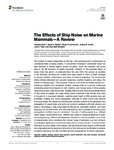The Effects of Ship Noise on Marine Mammals—A Review
| dc.contributor.author | Erbe, C | |
| dc.contributor.author | Marley, SA | |
| dc.contributor.author | Schoeman, RP | |
| dc.contributor.author | Smith, JN | |
| dc.contributor.author | Trigg, LE | |
| dc.contributor.author | Embling, Clare | |
| dc.date.accessioned | 2021-10-13T12:06:43Z | |
| dc.date.available | 2021-10-13T12:06:43Z | |
| dc.date.issued | 2019-10-11 | |
| dc.identifier.issn | 2296-7745 | |
| dc.identifier.issn | 2296-7745 | |
| dc.identifier.other | ARTN 606 | |
| dc.identifier.uri | http://hdl.handle.net/10026.1/18044 | |
| dc.description.abstract |
The number of marine watercraft is on the rise—from private boats in coastal areas to commercial ships crossing oceans. A concomitant increase in underwater noise has been reported in several regions around the globe. Given the important role sound plays in the life functions of marine mammals, research on the potential effects of vessel noise has grown—in particular since the year 2000. We provide an overview of this literature, showing that studies have been patchy in terms of their coverage of species, habitats, vessel types, and types of impact investigated. The documented effects include behavioral and acoustic responses, auditory masking, and stress. We identify knowledge gaps: There appears a bias to more easily accessible species (i.e., bottlenose dolphins and humpback whales), whereas there is a paucity of literature addressing vessel noise impacts on river dolphins, even though some of these species experience chronic noise from boats. Similarly, little is known about the potential effects of ship noise on pelagic and deep-diving marine mammals, even though ship noise is focused in a downward direction, reaching great depth at little acoustic loss and potentially coupling into sound propagation channels in which sound may transmit over long ranges. We explain the fundamental concepts involved in the generation and propagation of vessel noise and point out common problems with both physics and biology: Recordings of ship noise might be affected by unidentified artifacts, and noise exposure can be both under- and over-estimated by tens of decibel if the local sound propagation conditions are not considered. The lack of anthropogenic (e.g., different vessel types), environmental (e.g., different sea states or presence/absence of prey), and biological (e.g., different demographics) controls is a common problem, as is a lack of understanding what constitutes the ‘normal’ range of behaviors. Last but not least, the biological significance of observed responses is mostly unknown. Moving forward, standards on study design, data analysis, and reporting are badly needed so that results are comparable (across space and time) and so that data can be synthesized to address the grand unknowns: the role of context and the consequences of chronic exposures. | |
| dc.format.extent | 606- | |
| dc.language.iso | en | |
| dc.publisher | Frontiers Media | |
| dc.subject | auditory masking | |
| dc.subject | chronic noise exposure | |
| dc.subject | marine watercraft | |
| dc.subject | ship noise emission | |
| dc.subject | commercial shipping | |
| dc.subject | marine mammal | |
| dc.subject | behavioral response | |
| dc.title | The Effects of Ship Noise on Marine Mammals—A Review | |
| dc.type | journal-article | |
| dc.type | Review | |
| dc.type | Journal | |
| plymouth.author-url | https://www.webofscience.com/api/gateway?GWVersion=2&SrcApp=PARTNER_APP&SrcAuth=LinksAMR&KeyUT=WOS:000490151000001&DestLinkType=FullRecord&DestApp=ALL_WOS&UsrCustomerID=11bb513d99f797142bcfeffcc58ea008 | |
| plymouth.volume | 6 | |
| plymouth.publication-status | Published online | |
| plymouth.journal | Frontiers in Marine Science | |
| dc.identifier.doi | 10.3389/fmars.2019.00606 | |
| plymouth.organisational-group | /Plymouth | |
| plymouth.organisational-group | /Plymouth/Faculty of Science and Engineering | |
| plymouth.organisational-group | /Plymouth/Faculty of Science and Engineering/School of Biological and Marine Sciences | |
| plymouth.organisational-group | /Plymouth/REF 2021 Researchers by UoA | |
| plymouth.organisational-group | /Plymouth/REF 2021 Researchers by UoA/UoA07 Earth Systems and Environmental Sciences | |
| plymouth.organisational-group | /Plymouth/Users by role | |
| plymouth.organisational-group | /Plymouth/Users by role/Academics | |
| dcterms.dateAccepted | 2019-09-11 | |
| dc.rights.embargodate | 2021-10-14 | |
| dc.identifier.eissn | 2296-7745 | |
| dc.rights.embargoperiod | Not known | |
| rioxxterms.versionofrecord | 10.3389/fmars.2019.00606 | |
| rioxxterms.licenseref.uri | http://www.rioxx.net/licenses/all-rights-reserved | |
| rioxxterms.licenseref.startdate | 2019-10-11 | |
| rioxxterms.type | Journal Article/Review |


